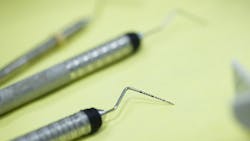Charging a separate fee for periodontal charting
Dear Dianne,
I recently started a job as a dental hygienist at a private practice and I’ve worked here a few weeks now. I was told during the interview that patients are charged $35 for periodontal charting. The initial charting is free, but after that they expect hygienists to inform patients during their hygiene appointments that future chartings are not complimentary.
The office manager (OM) is the owner’s wife, and it appears that everyone in the office disagrees with her on this issue. It has been a source of contention for at least five years. During the interview, she explained that we are to educate patients that periodontal charting is an important part of our diagnostic exam, hence the extra fee. She compared it to exposing and charging for radiographs.
However, charging for perio charting has caused a situation where the hygienists have been performing just a periodontal screening and recording (PSR) and not charging patients. Or they’ve been doing the charting without telling patients that they are charging a separate fee, and the front desk just zeroes out the fee. The owner’s wife has been checking charts and finding out that the charting is performed and often not charged.
I called our state dental association and spoke with a lawyer about this. His advice was to have a staff meeting so we can discuss this issue. The goal would be to let the office manager know that charging for the procedure limits us in being able to diagnose if a patient declines. I believe that if we create a situation where a patient can refuse, I can only provide a prophy, no matter what someone’s periodontal status may be. I view the periodontal charting as a service that is provided in order to help patients make informed decisions about the status of their health, thereby enabling them to proceed with treatments that may ultimately be more profitable for the practice.
I realize that the OM has the right to charge for this service, but there are people who refuse because of the fee. Clearly it is not for us to judge why, nor should we let finances inhibit the way we inform and treat patients. But I believe we could find other ways to make the practice profitable, such as providing products for purchase such as Waterpiks and electric toothbrushes, or implementing assisted hygiene.
I’ve been a dental hygienist for 21 years and have never been faced with this dilemma. My gut instinct tells me it is not right to charge separately for periodontal charting. But I do understand that the OM is trying to place importance on the procedure for patients. I would love to know your thoughts on this.
Midwest RDH
Dear Midwest,
Charging a separate fee for periodontal probing and charting plus an exam is known as “unbundling” and is considered inappropriate. The American Dental Association defines unbundling of procedures as “the separating of a dental procedure into component parts with each part having a charge, so that the cumulative charge of the components is greater than the total charge to patients who are not beneficiaries of a dental benefit plan for the same procedure.”
It is considered inappropriate to use several codes (unbundling) to describe a service on a claim where one code is sufficient. An example of unbundling would be a dentist who charges not just for the extraction, but also for elevating the flap, curetting out the periapical tissue, the incision, and suturing the socket. These procedures are all part of the global fee for extraction of the tooth.
If we examine the descriptors for the exam codes D0120 and D0150, we can see that periodontal evaluation is included in the descriptors:
“D0120—Periodic oral evaluation: An evaluation performed on a patient of record to determine any changes in the patient’s dental and medical health status since a previous comprehensive or periodic evaluation. This includes an oral cancer evaluation and periodontal screening where indicated.”
“D0150—Comprehensive oral evaluation: Evaluation and recording of dental caries, missing or unerupted teeth, restorations, existing prothesis, occlusal relationships, periodontal conditions (including periodontal screening and/or charting), hard and soft tissue anomalies, and more.”
If a patient has signs and symptoms or certain risk factors (such as smoking or diabetes) for periodontal disease, you could use the code D0180 when the full-mouth charting and recording is performed for the patient. Many offices use D0120 on routine exams and D0180 (and charge a higher fee) for periodontal patients.
D0180—Comprehensive periodontal evaluation: This procedure is indicated for patients who show signs or symptoms of periodontal disease and for patients with risk factors such as smoking or diabetes. It includes evaluation of periodontal conditions, probing, and charting.1
The first sentence is key, i.e., “Patients showing signs or symptoms of periodontal disease . . .” As we know, every adult patient should have a full-mouth periodontal charting once a year, but not all patients show signs of periodontal activity. If there are no signs or symptoms or documented risk factors for periodontal disease, you should not use D0180. Be warned that third-party payers will sometimes reduce reimbursement of D0180 to D0120. PSR is a screening tool only and never takes the place of a comprehensive perio exam. I do not advocate using PSR in place of a full-mouth charting and recording, as it could be considered an incomplete charting in a court of law. We used PSR when I was teaching to decide if a patient in our clinic should be with a freshman or a senior student.
There is no separate code for periodontal probing. However, as an example, let’s say a hygienist performs a D4910 and full periodontal charting with no dentist in the office, and no exam is charged out. The hygienist could use code D4999 in that case for the probing and recording. If the patient is out-of-network, he or she is responsible for the fee but may complain. If this is an in-network situation, then the PPO typically disallows the charge and it must be written off.
Charging a separate fee in addition to an evaluation fee for periodontal charting is a terrible idea. If you have to inform patients first, it gives them a chance to opt out. Then you may be violating the standard of care or jeopardizing the doctor’s ability to diagnose periodontal problems. I would expect pushback from patients.
I agree with your idea of finding other ways to increase productivity. Things that increase productivity include more efficient scheduling, adjunctive products including whitening, and implementing assisted hygiene. Maybe the office needs a general fee increase. Dr. Charles Blair’s Practice Booster and code books (practicebooster.com) are great ways to increase legitimate reimbursement and productivity.
I hope you can find a discreet way of helping the OM understand that the charging of a separate fee for periodontal charting when an exam is charged is considered unbundling and is not appropriate. Further, patients think dental fees are too high anyway, and having extra fees tacked onto their bills is sure to cause some patients to go elsewhere for their care. It’s simply not worth it.
All the best,
Dianne
Reference
- Code on Dental Procedures and Nomenclature (CDT Code). American Dental Association website. https://www.ada.org/en/publications/cdt.
DIANNE GLASSCOE WATTERSON, MBA, RDH, is a consultant, speaker, and author. She helps good practices become better through practical analysis and teleconsulting. Visit her website at wattersonspeaks.com. For consulting or speaking inquiries, contact Watterson at [email protected] or call (336) 472-3515.
About the Author
Dianne Glasscoe Watterson, MBA, RDH
DIANNE GLASSCOE WATTERSON, MBA, RDH, is a consultant, speaker, and author. She helps good practices become better through practical analysis and teleconsulting. Visit her website at wattersonspeaks.com. For consulting or speaking inquiries, contact Watterson at [email protected] or call (336) 472-3515.
Updated June 30, 2020

